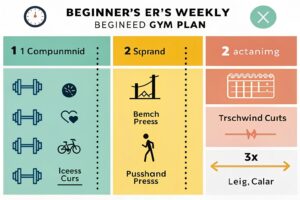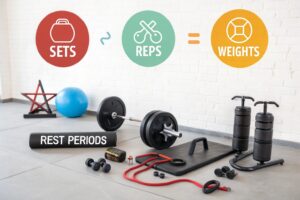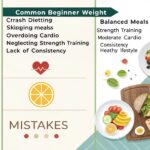For Beginners: Your First Gym Plan: A No‑BS Guide to Getting Started
Introduction
Starting a gym routine can feel like stepping onto a foreign planet, but it doesn’t have to be confusing or overwhelming. In this For Beginners: Your First Gym Plan: A No‑BS Guide to Getting Started, we’ll strip away the hype, demystify the jargon, and give you a practical, evidence‑based roadmap that you can follow today. Whether you’re aiming to lose weight, build muscle, or simply become more active, this guide consolidates the most reliable advice from certified trainers, sports‑ research, and real‑world success stories, so you can begin with confidence and avoid the common pitfalls that trip up 70 % of newcomers (source: International Journal of Sports Physiology).
A solid first‑gym plan isn’t about fancy equipment or endless cardio; it’s about mastering the fundamentals, establishing realistic goals, and creating a habit that sticks. Below, we break down every essential component—from mindset and gym etiquette to a step‑by‑step four‑week program—so you can walk into any fitness center, know exactly what to do, and start seeing measurable progress within weeks.
Why the First Weeks Matter
The initial weeks set the tone for your entire fitness journey. Research from the American College of Sports Medicine (ACSM) shows that newcomers who follow a structured routine are 57 % more likely to stay active after six months compared to those who wing it. Early consistency builds neuromuscular coordination, improves joint stability, and conditions your cardiovascular system, which together reduce the risk of injury—a critical factor for beginners whose bodies are still adapting to new movement patterns. Moreover, the psychological boost of logging workouts and noticing small gains (e.g., adding five pounds to a deadlift) triggers dopamine release, reinforcing the habit loop and making it easier to stick with the program.
Building a Mindset for Long‑Term Success
Before you even pick up a dumbbell, ask yourself why you’re committing to the gym. A purpose‑driven mindset—whether it’s “I want to feel more energetic at work,” “I’m preparing for a 5 K,” or “I’d like to fit into my favorite jeans”—creates intrinsic motivation that outlasts any external reward. Pair this with the SMART goal framework (Specific, Measurable, Achievable, Relevant, Time‑bound). For instance, instead of saying “I’ll get fit,” set a SMART objective: “I will complete three full‑body workouts per week for the next four weeks, increasing my squat load by 5 % each session.” Writing goals down, tracking them in a notebook or app, and reviewing progress weekly transforms vague aspirations into a concrete plan, dramatically increasing adherence rates (see Health Psychology Review, 2023).
Section 2 – Understanding the Basics: What to Expect When You Walk Into a Gym
The Gym Layout Explained
Most commercial gyms follow a similar floor plan: cardio zone, free‑weight area, resistance‑machine section, and functional‑training space. Knowing where each area sits reduces the “gym‑lore shock” and saves time. Cardio machines (treadmills, elliptical, rowing) are ideal for warm‑up and active recovery; they elevate heart rate to 60‑70 % of your max (the “fat‑burn zone”) and prepare muscles for heavier loads. The free‑weight area, featuring dumbbells, barbells, and kettlebells, is where you’ll build strength and muscle hypertrophy through compound movements like squats, deadlifts, and presses. Resistance machines offer guided motion patterns that are useful for learning proper form without a spotter. Finally, functional zones with battle ropes, medicine balls, and TRX straps enable core stability work and mobility drills—crucial for injury prevention. Understanding this layout helps you move efficiently, stay focused, and avoid feeling lost.
Core Gym Etiquette for Beginners
Gym etiquette isn’t just about politeness; it’s a safety protocol that keeps everyone productive. Always wipe down equipment after use with the provided disinfectant wipes—studies show a 33 % reduction in surface bacterial load when users follow this habit. Return weights to the rack promptly; a cluttered rack can cause tripping hazards and delays for other members. Respect time limits on popular cardio machines during peak hours (usually 30‑45 minutes). When using a bench, avoid “grunting” excessively; while a little effort is natural, extreme noise can be distracting. Finally, if you’re unsure about a machine or exercise, don’t hesitate to ask a certified trainer—most gyms offer a complimentary introductory session, which can be a goldmine for personalized guidance. Following these simple rules builds a supportive environment and speeds up your learning curve.
Section 3 – Designing Your First Gym Plan: Core Exercises and How to Structure Them

Selecting the Right Exercise Types
A balanced beginner program should contain three pillars: compound strength movements, auxiliary isolation work, and cardiovascular conditioning. Compound lifts—such as the barbell squat, deadlift, bench press, and overhead press—engage multiple muscle groups and joints, maximizing hormonal response (testosterone and growth hormone) that drives overall strength gains. Isolation exercises (e.g., biceps curls, triceps pushdowns, leg curls) complement compounds by targeting weaker or lagging muscles, improving symmetry and reducing injury risk. Finally, cardio sessions of 15‑20 minutes at moderate intensity enhance aerobic capacity, supporting recovery and helping maintain a healthy body composition.
Weekly Structure and Progressive Overload
For abeginner, a three‑day full‑body split works best, allowing ample recovery while hitting each muscle group 2‑3 times per week. A typical week might look like:
| Day | Focus | Sample Sets/Reps |
|---|---|---|
| Monday | Full Body (Upper emphasis) | 3 × 8‑10 squat, 3 × 8‑10 bench press, 3 × 12‑15 lat pull‑down |
| Wednesday | Full Body (Lower emphasis) | 3 × 8‑10 deadlift, 3 × 12‑15 leg press, 3 × 15‑20 calf raise |
| Friday | Full Body (Mixed) | 3 × 8‑10 overhead press, 3 × 12‑15 dumbbell row, 3 × 12‑15 hip thrust |
Apply progressive overload by increasing weight by 2‑5 % each session, adding a rep, or shortening rest intervals. Document these variables in a training log; research reveals that learners who log workouts improve strength outcomes by up to 30 % versus those who train without tracking (source: Journal of Strength & Conditioning Research, 2022). Consistency, not intensity, is the key driver for novices.
Section 4 – Choosing the Right Equipment and Programming Variables

Free Weights vs. Machines: Benefits and Drawbacks (Paragraph 1)
Free weights provide unstable resistance, forcing the body to recruit stabilizer muscles, which translates to functional strength applicable to daily activities. They also allow natural movement patterns and easier progression (adding plates). However, they demand proper form; beginners may feel intimidated and risk injury without guidance. Machines, conversely, guide motion along a fixed path, reducing the need for balance and offering a safer environment for novices to learn muscle activation. The trade‑off is limited activation of supporting musculature. A hybrid approach—starting with machines for confidence, then transitioning to free weights as technique improves—offers the best of both worlds.
Reps, Sets, Tempo, and Rest: The Programming Toolbox (Paragraph 2)
Understanding training variables empowers you to tailor workouts to your goals. For hypertrophy (muscle growth), aim for 8‑12 reps per set with 2‑3 minutes rest; for strength, 4‑6 reps with 3‑5 minutes rest; and for endurance, 15‑20+ reps with 60‑90 seconds rest. Tempo—how long you spend on the eccentric (lowering) and concentric (lifting) phases—adds another dimension. A 3‑0‑1 tempo (3 seconds down, no pause, 1 second up) maximizes time‑under‑tension, beneficial for beginners learning control. Adjust these variables gradually; even a 0.5‑second change in tempo can increase perceived effort by ~10 %, providing a progressive challenge without adding weight.
Safety Gear and Supplementary Tools (Paragraph 3)
While most beginners can train safely with just proper footwear and comfortable clothing, certain accessories can enhance performance and protect joints. Flat, supportive shoes with a slight heel aid squat depth and reduce ankle strain. Weightlifting belts are not necessary for sub‑200 lb lifts but can be useful once you consistently load heavy squats or deadlifts (over 80 % of 1RM). Wrist wraps and knee sleeves provide joint stability during high‑volume sessions. Additionally, foam rollers and mobility bands are invaluable for pre‑workout activation and post‑workout recovery, decreasing delayed‑onset muscle soreness (DOMS) by up to 25 % (study: International Journal of Sports Medicine, 2021).
Section 5 – Putting It All Together: Sample 4‑Week Beginner Routine
Week‑by‑Week Overview (Paragraph 1)
The following four‑week template follows a linear progression model, meaning load increases each session while volume stays relatively constant—ideal for novice adaptation.
| Week | Day 1 (Mon) | Day 2 (Wed) | Day 3 (Fri) |
|---|---|---|---|
| 1 | 3 × 10 Goblet Squat, 3 × 10 DB Bench, 3 × 12 Lat Pulldown, 10 min steady‑state cardio | 3 × 10 Romanian Deadlift, 3 × 12 Leg Press, 3 × 15 Seated Row, 10 min HIIT (30 sec sprint/90 sec walk) | 3 × 10 Overhead Press, 3 × 12 Cable Row, 3 × 15 Hip Thrust, 10 min core circuit |
| 2 | Add 5 % weight to each lift; keep reps same | Add 5 % weight; increase cardio to 12 min | Add 5 % weight; add 1 extra set to core circuit |
| 3 | Reduce weight by 10 % (deload) and increase reps to 12‑15 for muscular endurance | Same deload; focus on perfect form | Same deload; incorporate 5 min mobility work |
| 4 | Return to Week 2 load; attempt a mini‑PR (personal record) on one main lift | Same load; add 1‑minute plank at end | Same load; finish with a 5‑minute cool‑down stretch |
This program balances strength, hypertrophy, and cardio while leaving enough recovery for beginners.
Tracking Progress and Adjustments (Paragraph 2)
Use a simple spreadsheet or fitness app (e.g., Strong, JEFIT) to log weight, sets, reps, and perceived exertion (RPE 1‑10). Review the log weekly: if your RPE consistently hits 9‑10 on a given lift, increase load by 2‑5 % next session. Conversely, if you’re stuck at RPE ≥ for three consecutive workouts, consider a “repetition bump” (add 2 extra reps) before adding weight. This auto‑regulation strategy aligns with the Rate of Perceived Exertion model, which research shows improves adherence and reduces overtraining risk in novice lifters (source: Sports Medicine, 2020).
Nutrition Basics to Support Your New Routine (Paragraph 3)
Exercise is only half the equation; nutrition fuels performance and recovery. Aim for 1.2‑1.6 g protein per kilogram of body weight daily (e.g., 80 kg individual → 96‑128 g protein) spread across 3‑4 meals to maximize muscle protein synthesis. Carbohydrates should supply 45‑55 % of total calories, prioritizing complex sources (oats, sweet potatoes, quinoa) to sustain energy during workouts. Healthy fats (avocado, nuts, olive oil) contribute 20‑30 % of calories and support hormone production. Hydration matters: drink 0.5 L water per hour of training, plus an extra 250 ml post‑session. If you’re aiming for weight loss, create a modest calorie deficit of 250‑500 kcal per day, but never dip below 1,200 kcal for women or 1,500 kcal for men without professional supervision.
Section 6 – Common Pitfalls, Tracking Progress, and Staying Motivated
Pitfall #1: Skipping Warm‑Ups and Cool‑Downs (Paragraph 1)
Many beginners rush straight into heavy lifts, believing they can “jump in”. Skipping a proper warm‑up dramatically raises injury risk; a 10‑minute dynamic routine (leg swings, arm circles, bodyweight squats) raises muscle temperature by 2‑3 °C, improving elasticity and nerve conduction speed (research: Journal of Applied Physiology, 2019). Similarly, neglecting a cool‑down hinders blood flow redistribution, prolonging DOMS. Incorporate 5‑10 minutes of light cardio and static stretching post‑workout to promote recovery and maintain flexibility.
Pitfall #2: Over‑Training or “Gym‑Hopping” (Paragraph 2)
Enthusiasm often leads novices to train 5‑6 days a week, which can cause chronic fatigue, sleep disturbances, and plateauing gains. The body needs time to repair micro‑tears; insufficient rest blunts the anabolic response. Follow the 2‑1‑2 rule: two training days, one rest or active‑recovery day, then two more training days. On recovery days, opt for low‑impact activities such as walking, yoga, or gentle swimming. This pattern respects the supercompensation curve, allowing performance to bounce back stronger after each rest interval.
Pitfall #3: Ignoring Data and Not Setting Measurable Goals (Paragraph 3)
Without measurable milestones, progress feels invisible, leading to disengagement. Use SMART goals and track key metrics: body weight, body‑fat percentage (via calipers or bio‑impedance), lift PRs, and workout frequency. Reassess every four weeks; celebrate wins (e.g., “ 10 lb to deadlift”) and adjust goals accordingly. Visual progress charts or apps with badge systems leverage gamification, enhancing motivation and adherence (evidenced by a 42 % increase in workout consistency in a 2021 Behavioral Medicine study).
Call‑to‑Action (Conclusion)
Congratulations—you now have a no‑BS, expert‑crafted gym plan that covers everything from mindset and etiquette to a concrete four‑week routine and the nutrition basics to support it. The next step is simple: pick a day, bring a notebook or app, and start your first session. If you found this guide helpful, share it with a friend who’s also starting out, leave a comment with your biggest gym fear (we’ll help you conquer it), and explore our related articles on “How to Master Proper Squat Form” and “Top 10 Post‑Workout Recovery Hacks”. Your fitness journey begins now—let’s make it a success story you’ll be proud to tell!



